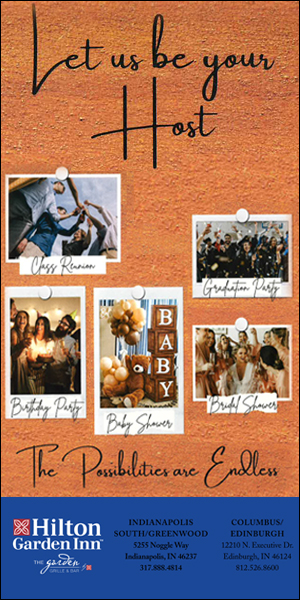
Hoosier designers help clients dress well
By CJ Woodring
Indiana most often isn’t renowned as the world’s fashion metropolis or even the nation’s. But the Hoosier State continues to gain global prominence through the works of custom designers whose apparel and accessories present price points for every budget.
It’s good news for fashion mavens who want to dress well, which in the United States sometimes seems like a lost art.
Linda Przybyszewski, associate professor of history at the University of Notre Dame, is well versed on the subject. For nearly 10 years she’s been teaching “Nation of Slobs: The Art, Ethics and Economics of Dress in Modern America,” a course she conceptualized to enlighten students. In 2014 she wrote “The Lost Art of Dress: The Women Who Once Made America Stylish.”
Professor Pski, as students call her, has been making most of her own clothes since she was a little girl. But much has changed on America’s fashion scene since the days the Chicago-area native first encountered a sewing machine.
She explains the phenomenon. “America once had ‘dress doctors’ who set the rules through teaching, radio programs and home economics classes. Those people are no longer in place, so people aren’t learning about different levels of formality and appropriate attire. Today’s rules seem to be that you cannot dress up.”
Fashion faux pas “clearly coincided with the 1960s, when we threw out rules of formality and life. I think style moved toward simplicity and eventually slipped into stupidity,” she says, noting the trend toward sloppy attire is uniquely American. “In Europe, there’s a certain formality for appearing in public that Americans have lost.”
It’s all about dressing for success in finely crafted, custom-fitted items that display beautiful features, precise stitching and elegant details and trim. And Prof Pski says it doesn’t take a lot of money or skill.
“It just takes knowledge,” she says. “Learn the principles of art and how they apply. And make sure whatever you buy fits your life occasions and is beautiful.”
With the assistance of Indiana designers such as the following, the art of dressing well — with elegance and class — needn’t remain lost.
A cut above
At a time when “Mad Men” apparel holds widespread appeal, a man in a gray flannel suit is rarely present in today’s workplace settings. However, discerning customers still desiring professional attire seek the services of Lee’s Custom Tailoring and proprietor Jin Lee.
A second-generation tailor, Lee began apprenticeship in his native South Korea in 1967. Since emigrating to the United States in 1985, he has provided custom-made men’s and women’s suits, sports coats, blazers, trousers, topcoats and shirts for distinguished clientele.
As Indiana’s only certified master tailor — there are just 25 in the United States and fewer than 300 worldwide — the Indianapolis resident offers suits that take between 25 to 40 hours and sometimes up to 100 hours to construct.
Lee’s customers range from 9 to 93 years old. His attention to detail, pride in workmanship and passion for excellence have won him multiple industry awards in what remains a niche market.
“Anyone can go to a department store, but there are not that many tailoring shops, even in Indianapolis,” Lee says. “Of those, I’m the only master tailor. Whatever they need, I make for them.”
Suit prices range from just shy of $800 to $20,000, depending upon whether they’re made-to-measure (MTM), custom-made bespoke or Oxxford bespoke.
Customers select from more than 5,000 wool and cashmere suit fabrics sourced from luxury cloth merchants. Shirts are constructed from luxury shirting that includes poplins, twills and cotton-cashmere blends. Consultations generally take about an hour.
Lee says custom suits in a majority of businesses are MTM. His MTM suits take about three to six weeks to complete, with one or two fittings.
“I also provide bespoke, the old, old handmade tailoring system. I make a pattern, like a blueprint,” he says. Suits are handmade, with delivery from four to eight weeks.
Finally, Oxxford bespoke is handmade in Chicago, based on Lee’s pattern and design, and delivered within six to 10 weeks.
Well-made custom suits most often include functional working cuffs and horn buttons, with optional details unseen by all but the wearer: monogrammed heel guards and suede collar felts.
The result? A beautiful, comfortable suit that will outlast mass-produced garments and identify the owner as a confident, well-dressed professional.
Luxurious leather
Ah, leather! Perhaps nothing else so eloquently whispers of elegance and good taste. And House of Fifth responds with a line of artisan quality handbags (pictured), travel bags, cuffs, bracelets and iPad cases.
Creative director and co-owner Truen Jaimes first began working in apparel design, then transitioned to leather goods. After years of pre-designing his product line, the North Carolina native, along with two friends, opened an Indianapolis atelier. His mother and brother eventually were involved.
“It definitely was my baby, my product line, but my friends helped me get a jump start. Then for about three years my mom helped with great feedback on samples, construction and technical details,” he says.
About a year ago, Jaimes returned the studio to his home, where he focuses on hand-stitched artisanal pieces. All work is done in-house, using state-of-the-art industrial equipment and full artisan handmade work benches.
Leather is sourced from throughout the world, with an eye for the best grade and price. Although Jaimes dyes in-house — he’s created about 19 different colors — most leather is vegetable tanned, creating a durable product that, with good care, can last a lifetime.
Jaimes says leather remains a big seller despite animal protectionists’ concerns. “One of the biggest things we propose is a higher-end leather with a more environmentally friendly dyeing process and a lower impact on the animal population. In fact, artisan leather goods have had a real spike in sales the last few years. People are just more conscious about how they impact the environment.”
Price points range from $7 for the SnapTech, which brings order to electronics cord chaos, to handbags and wallets for $100 to $200 all the way up to the St. Ellé traveler bag, priced at $15,000.
The designer’s client list extends globally. “Our clients are well-traveled. With our products, I think they appreciate they can get something locally they believe is comparable to what they can get in great cities they visit.
“A lot of them love accessories because they can spice up an ensemble, express their personality and have something different. As we dress more casually, it’s nice to have something upscale and still be comfortable at the same time.”
Material goods
Spring is in the air, and the fashion forecast signals bright pastels for the girls in their summer dresses: ultraviolet, lavender, crocus, dahlia.
Custom designed and constructed from natural fibers sourced from Chicago, New York City and California — cottons, linens, silk/hemp blends — the frocks are cool and comfortable, a return to yesteryear and simple authenticity. And they’re available at Indianapolis-based Erin Young Designs.
Founder and proprietor Young and her team offer bridal gowns, special occasion and everyday dresses and business fashion, presenting busy, business and hard-to-fit women — whether in their mid-20s or 90s — a special place to connect with quality apparel.
Services also include alterations and fashion consulting.
“In most other nations, it’s common for women to have their own tailor,” Young says. “It’s not even considered in the U.S., and young people here don’t even know how to use a sewing machine.
“Professional women at upper levels are in a quandary, because today’s business suits either show too much cleavage or the skirts are too tight. Then there are women shopping for everyday dresses who are hard to fit and must have everything altered.”
Young began working with fabric at the age of 5, and by the time she was 15 was undertaking high-end tailoring for men’s shirts and trousers. Following graduation from Purdue University, she attended the Fashion Institute of Technology and worked for Laura Ashley, both in New York City, also spending six months in Europe visiting design houses.
After working out of her home for two decades, the designer opened her fabric and dressmaking studio in 2012, relocating three years ago. Price points range from $120 for a short skirt to $1,500 for a wedding gown, depending upon detail. Fabric is additional.
“Our goal is to bring that higher-end product to clients, showing them the quality difference between off-the-rack versus custom-made that fits and looks well,” she says. “And it’s very rewarding, as a business, to see people so happy with how they look.”
Oh, chapeau!
For nearly eight years, former chef Amanda Joyner has been whipping up hats for clients who display the wearable art at local and global destinations that include weddings and community events, the Grammy Awards and the royal wedding.
Many are jaw droppers. Think a giant hummingbird clothed in 500 feathers. Or a 2-foot octopus that accompanied its owner in Coney Island’s Mermaid Parade.
But the custom-made creations needn’t be show stoppers: For the rest of us, there are cloches, pillboxes, boaters, swingers and more.
“Hats for everyday wear are coming back,” says Joyner, founder and owner of Chef Bizzaro Millinery in Michigan City. “People are starting to care about how they look. It’s a matter of being ‘put together’ and respecting yourself.”
And it doesn’t require breaking the piggy bank, she says.
“You can put on dress jeans and a T-shirt, and throw on a hat,” Joyner says. “A hat makes a statement, is magical and tells so much about a person.”
The Texas native grew up playing dress-up with her grandmother. With a love for vintage fashions, she first began making hats when her husband challenged her to duplicate an expensive one she loved. The designer is self-taught except for a “crash course” she took from milliner Joy Scott.
As with all attire, individuals want to be defined by what they wear. “I just had a bride who selected rose-gold antlers with a diamond band trim for her wedding,” Joyner says, noting overall price points range from $25 headpieces to large chapeaux costing hundreds of dollars.
This spring calls for bright pastel colors, textures such as sinamay (a type of straw) and leather and shapes including turbans. Joyner recently began using leather, a big seller in the U.K, and sources many supplies from Granger-based Judith M. Millinery Supply House.
The designer hopes women will begin considering hats as a “must have” accessory, adding there’s an antidote for not dressing well. “You must get in the mindset to get dressed up every day, even if you don’t feel like it. Throw on a little hat. It will make you look and feel good, while changing your day, week, year and life.”


